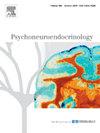社会隔离,而不是伴侣分离,降低了雌性加利福尼亚小鼠的海马突触体线粒体呼吸。
IF 3.6
2区 医学
Q2 ENDOCRINOLOGY & METABOLISM
引用次数: 0
摘要
社会孤立、孤独和丧失对健康和生活质量产生了深远的影响,但这些结构的复杂性可能会妨碍在啮齿动物模型中进行机械检查。评估环境操纵对社会啮齿动物的外周和神经影响,如加利福尼亚小鼠(Peromyscus californicus),可以促进探究经历不同类型损失的生物学影响。压力源可以损害海马的神经功能,这种影响的一部分是由于突触线粒体功能的缺陷。突触上的线粒体对促进神经传递至关重要,损伤会损害神经传递,从而损害行为。在目前的研究中,我们使用遗传上一夫一妻制的雄性和雌性加利福尼亚小鼠来评估在移除同性笼子伴侣10天或30天(即社会隔离,实验1)或在同居10天后与异性伴侣分离10天(即伴侣分离,实验2)后的突触线粒体呼吸。在社会隔离组中,男性(而非女性)表现出与长期应激反应一致的身体变化,包括在隔离后体重减少和肾上腺肥大。相比之下,在社会隔离后的10天和30天,与仍然是成对居住的雌性小鼠相比,被隔离的雌性小鼠表现出海马突触线粒体呼吸的减少。在男性中没有观察到影响。社会隔离并没有改变男女在野外的结果。然后,我们调查了与异性伴侣分离对相同指标的影响。与异性伴侣分离在质量上的影响较小,因此在与异性伴侣分离后,在体重、肾上腺重量、开阔场地行为或线粒体呼吸方面没有观察到统计学上显著的变化。总的来说,这些数据表明雄性和雌性社会压力对突触线粒体呼吸的影响是不同的。本文章由计算机程序翻译,如有差异,请以英文原文为准。
Social isolation, but not partner separation, lowers hippocampal synaptosome mitochondrial respiration in female California mice (Peromyscus californicus)
Social isolation, loneliness, and loss profoundly impact health and quality of life, but the complex nature of these constructs can prohibit mechanistic examination in rodent models. Assessment of the peripheral and neural effects of environment manipulations in a social rodent species, such as California mice (Peromyscus californicus), can facilitate inquiry into the biological repercussions of experiencing different types of loss. Stressors can compromise neural function in the hippocampus and a portion of this effect is due to deficits in mitochondrial function at the synapse. Mitochondria at the synapse are essential to facilitate neural transmission and compromise can impair neurotransmission and thereby behavior. In the current study, we used genetically monogamous male and female California mice to evaluate synaptic mitochondrial respiration following removal of a same-sex cage mate for 10- or 30-days (i.e., social isolation; Experiment 1) OR a 10-day separation from an opposite-sex partner following 10-days of cohabitation (i.e., partner separation; Experiment 2). In the social isolation cohort, males, but not females, exhibited physical changes consistent with a prolonged stress response, including reduction in body mass and hypertrophy of the adrenal glands following isolation. In contrast, isolated female mice demonstrated a reduction in hippocampal synaptic mitochondrial respiration at both 10- and 30-days following social isolation, compared to females that remained pair-housed. No effects were observed in males. Social isolation did not alter open field outcomes for either sex. We then investigated the impact of separation from an opposite sex partner on the same metrics. Separation from an opposite sex partner was qualitatively less impactful, such that there were no statistically significant changes observed in body mass, adrenal weight, open field behavior, or mitochondrial respiration following separation from an opposite sex mate. Collectively, these data suggest that males and females differentially manifest the impact of social stress on synaptic mitochondria respiration.
求助全文
通过发布文献求助,成功后即可免费获取论文全文。
去求助
来源期刊

Psychoneuroendocrinology
医学-精神病学
CiteScore
7.40
自引率
8.10%
发文量
268
审稿时长
66 days
期刊介绍:
Psychoneuroendocrinology publishes papers dealing with the interrelated disciplines of psychology, neurobiology, endocrinology, immunology, neurology, and psychiatry, with an emphasis on multidisciplinary studies aiming at integrating these disciplines in terms of either basic research or clinical implications. One of the main goals is to understand how a variety of psychobiological factors interact in the expression of the stress response as it relates to the development and/or maintenance of neuropsychiatric illnesses.
 求助内容:
求助内容: 应助结果提醒方式:
应助结果提醒方式:


